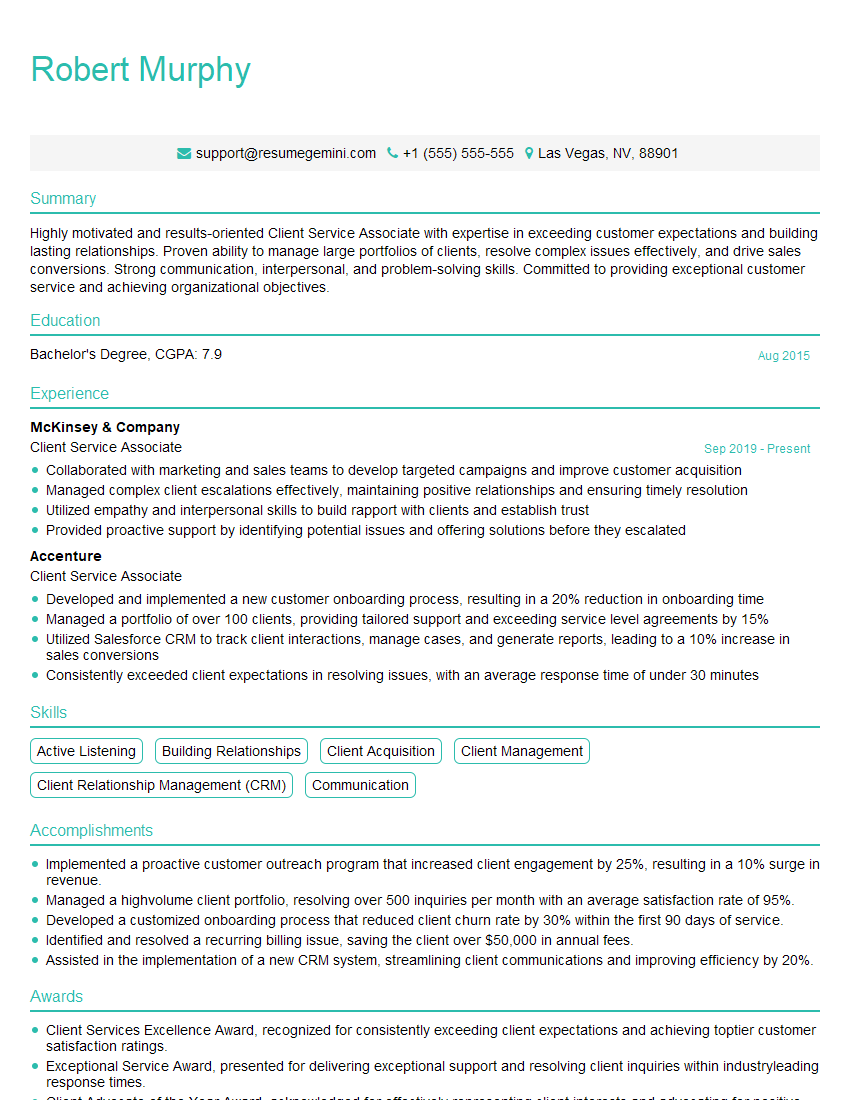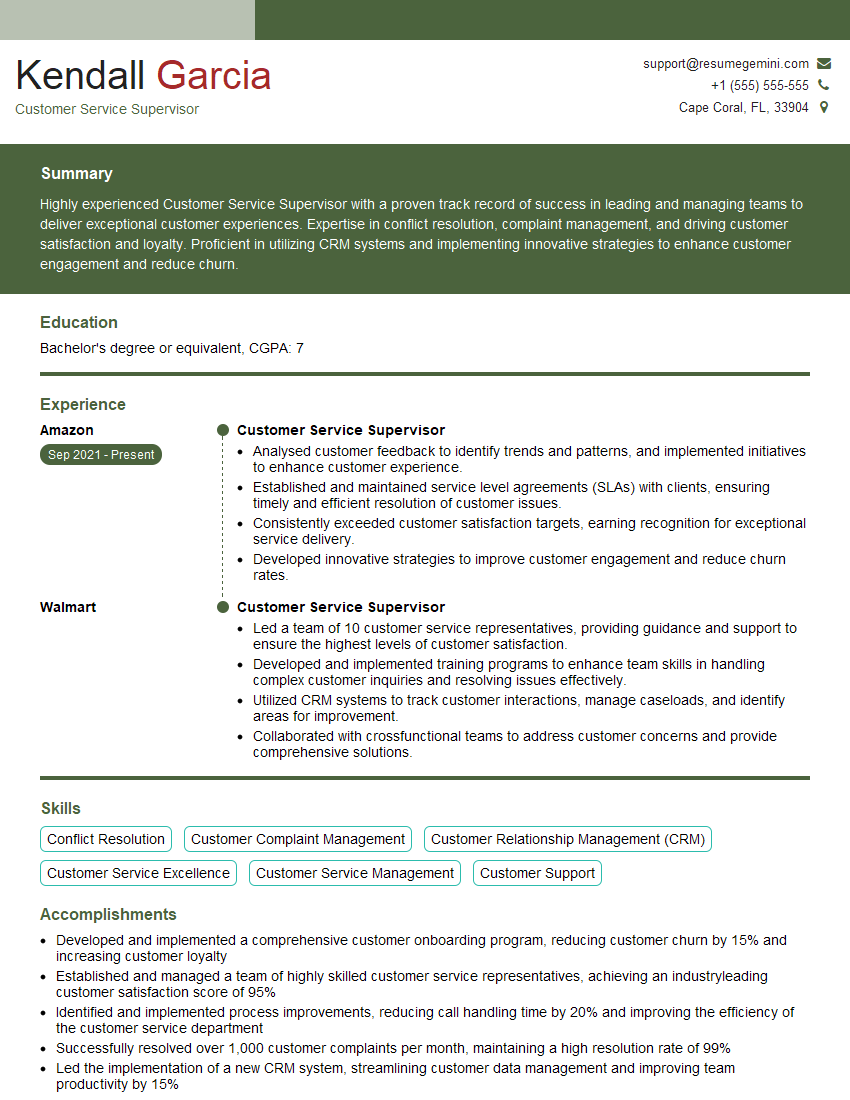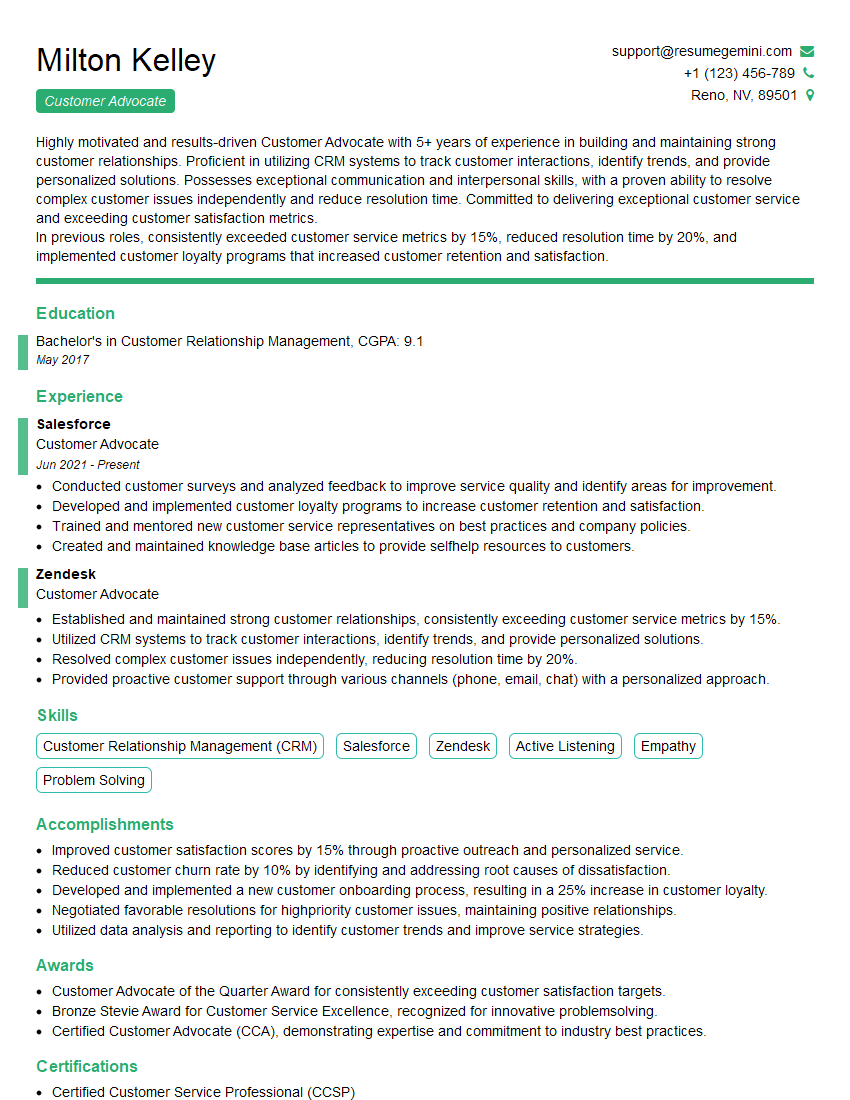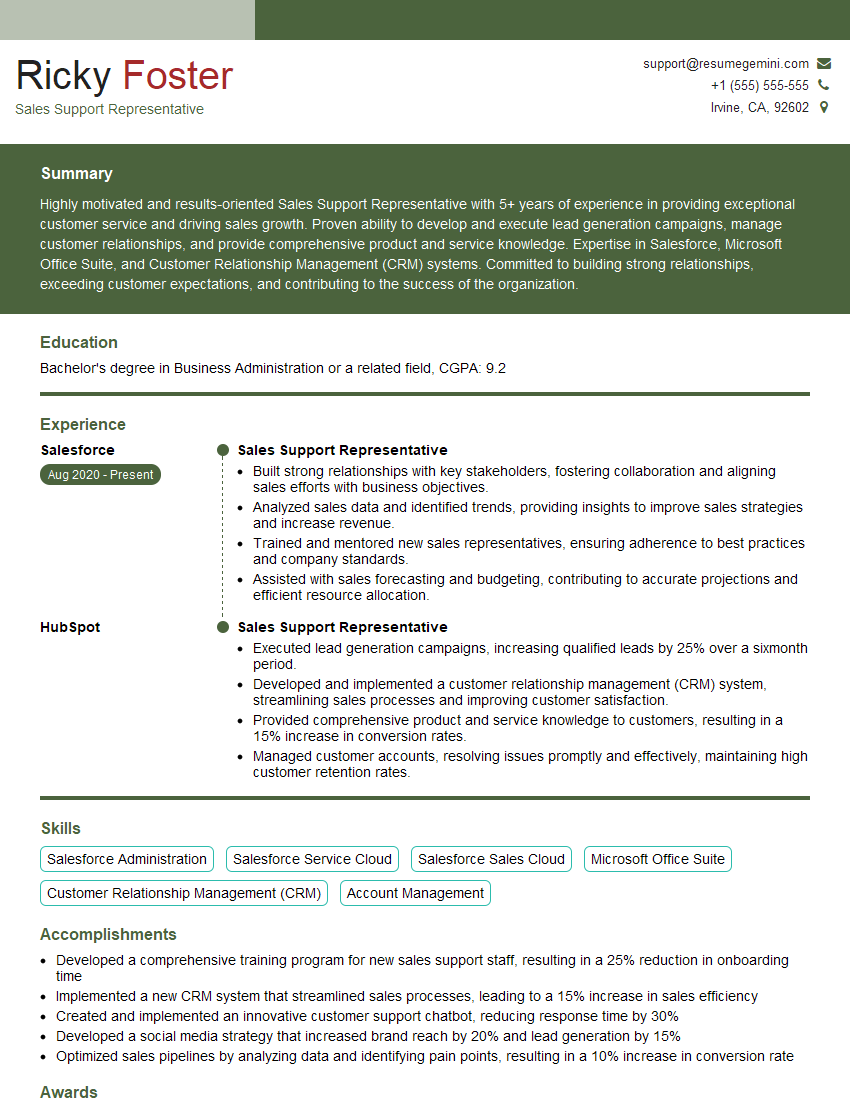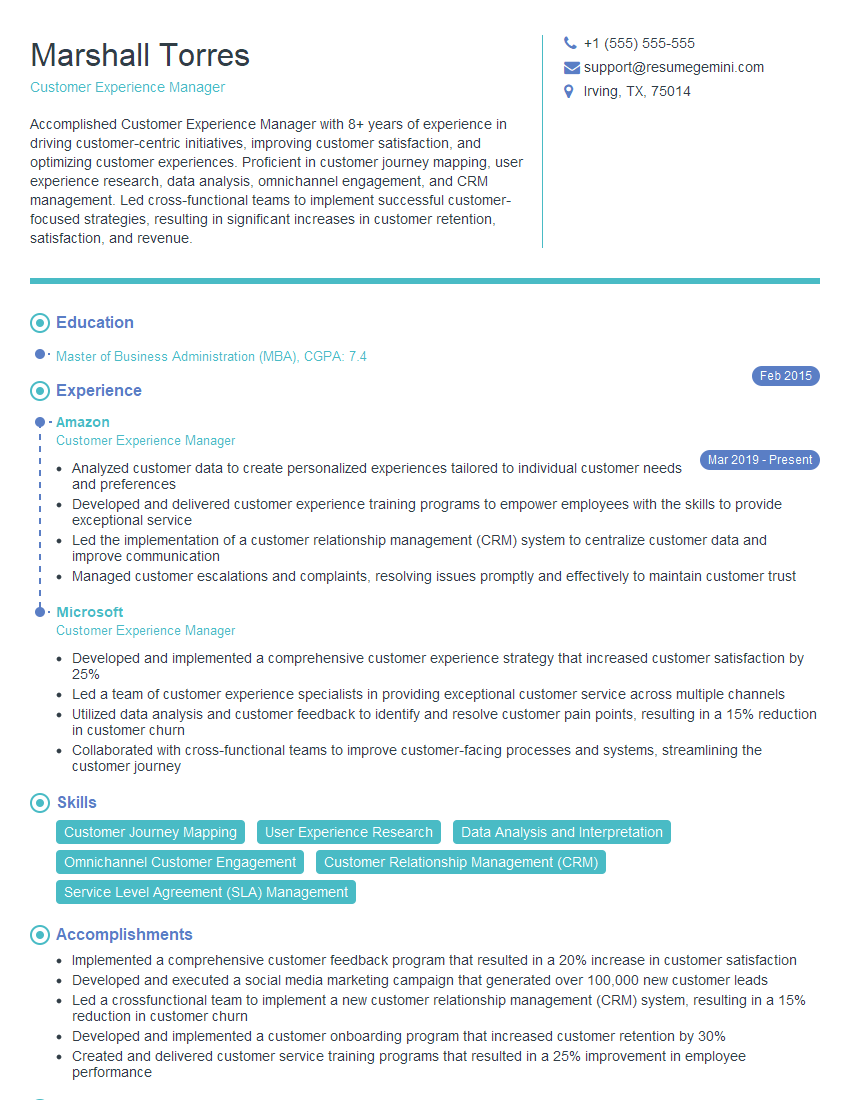Feeling uncertain about what to expect in your upcoming interview? We’ve got you covered! This blog highlights the most important Enthusiasm for Customer Service interview questions and provides actionable advice to help you stand out as the ideal candidate. Let’s pave the way for your success.
Questions Asked in Enthusiasm for Customer Service Interview
Q 1. Describe a time you went above and beyond for a customer.
Going above and beyond for a customer means exceeding their expectations and demonstrating a genuine commitment to their satisfaction. It’s about proactively identifying needs and offering solutions that go beyond the standard procedure.
For example, I once had a customer whose package arrived damaged. While our standard procedure was to issue a refund or replacement, I understood this customer needed the item urgently for a crucial presentation. I personally contacted our warehouse, expedited a new shipment, and even followed up with the customer to ensure it arrived on time and in perfect condition. This extra effort built trust and loyalty. I didn’t just solve the problem; I provided a superior experience that left them incredibly grateful.
Q 2. How do you maintain a positive attitude when dealing with difficult customers?
Maintaining a positive attitude when dealing with difficult customers is crucial for effective customer service. It’s about understanding that their frustration often stems from a genuine problem, not a personal attack. My approach involves active listening, empathy, and a commitment to finding a resolution.
I practice emotional intelligence, acknowledging their feelings without getting defensive. I use phrases like, “I understand your frustration,” or “I can see why you’re upset.” This shows I’m listening and validates their emotions. I then focus on the problem itself, offering solutions and demonstrating a genuine desire to help. Taking a short, calm break if needed also helps prevent escalation.
Q 3. What strategies do you use to build rapport with customers quickly?
Building rapport quickly is about establishing a connection and making the customer feel valued. I start by using a warm, friendly tone and addressing them by name if possible. I actively listen to understand their needs, showing genuine interest in their situation.
Mirroring their communication style – whether it’s formal or informal – helps create a sense of comfort. Asking open-ended questions, like “Can you tell me more about…” encourages them to share details, allowing me to personalize the interaction and demonstrate understanding. Finding common ground, if possible, also builds connection, like mentioning a shared interest if it arises naturally.
Q 4. How do you handle customer complaints effectively and efficiently?
Handling customer complaints effectively involves a structured approach. First, I listen attentively and let the customer fully express their concerns without interruption. Then, I paraphrase their complaint to confirm my understanding. This shows I’m paying attention and helps avoid misunderstandings.
Next, I apologize sincerely for the inconvenience, even if the issue isn’t directly my fault. This doesn’t mean admitting guilt, but simply acknowledging their negative experience. I then work collaboratively to find a solution, outlining the steps I will take and keeping the customer informed every step of the way. Finally, I follow up to ensure they are satisfied and address any remaining concerns.
Q 5. Share an example of how you resolved a challenging customer issue.
I once had a customer who was furious because a product they ordered was significantly delayed. They had already cancelled the order through the online portal, but due to a system glitch, the cancellation didn’t register and the product shipped.
Instead of simply saying ‘the system is the issue’, I took ownership of the situation. I apologized profusely for the inconvenience, explained the technical issue, and offered several options: a full refund, a significant discount on a future purchase, or a donation to their charity of choice in lieu of the product. The customer appreciated the options and chose the donation, feeling heard and valued. Following up with a personal email thanking them for their understanding further reinforced the positive resolution.
Q 6. How do you stay motivated and enthusiastic in a customer service role?
Staying motivated and enthusiastic in customer service requires a multifaceted approach. Firstly, I focus on the positive impact I make on customers’ lives. Knowing I’m helping people solve problems and providing a positive experience is intrinsically rewarding.
Secondly, I actively seek professional development opportunities to enhance my skills and knowledge. This keeps my work engaging and prevents stagnation. Thirdly, I maintain healthy work-life balance to avoid burnout. Finally, I appreciate and celebrate successes, both big and small, to foster a sense of accomplishment and maintain my enthusiasm.
Q 7. Describe your approach to prioritizing customer needs.
Prioritizing customer needs involves a combination of factors. Urgency plays a significant role; customers with immediate issues or critical needs naturally take precedence. However, I also consider the overall impact and potential consequences of delayed responses.
I employ a triage system, mentally assessing each request based on urgency and impact. I use tools like ticketing systems to track and manage requests effectively, prioritizing based on the criteria mentioned above. Transparency is key; I keep customers informed about the status of their requests and any anticipated delays, managing their expectations effectively.
Q 8. How do you handle multiple customer requests simultaneously?
Handling multiple customer requests simultaneously requires a structured approach and excellent organizational skills. I employ a system of prioritization, often using a ticketing system or similar tool to manage incoming requests. This allows me to triage requests based on urgency and impact. For example, a customer experiencing a service outage needs immediate attention, while a general inquiry can wait. I use time-blocking techniques to allocate specific time slots for different tasks, ensuring I dedicate sufficient time to each customer without feeling overwhelmed. I also leverage quick response strategies like canned responses for frequently asked questions to save time while maintaining a personalized touch. Imagine it like a conductor leading an orchestra; each instrument (customer request) needs attention, but the conductor ensures a harmonious performance by managing the timing and prioritization effectively.
- Prioritize urgent requests.
- Use ticketing systems for organization.
- Employ time-blocking techniques.
- Utilize canned responses for efficiency.
Q 9. How do you use empathy to connect with customers?
Empathy is the cornerstone of excellent customer service. It’s about stepping into the customer’s shoes and understanding their perspective, even if you don’t necessarily agree with it. I achieve this by actively listening, paying close attention to both verbal and nonverbal cues. For instance, if a customer sounds frustrated, I might say something like, “I understand this is frustrating; let’s work together to find a solution.” I also try to personalize the interaction, remembering details from previous conversations if applicable. This shows the customer that I value their time and their individual situation. Empathy is not about agreeing with the customer; it’s about acknowledging their feelings and working towards a resolution that meets their needs.
For example, if a customer is upset about a delayed delivery, I wouldn’t just apologize for the delay; I would also acknowledge the inconvenience it has caused them – perhaps they were looking forward to using the product for a special occasion. By validating their emotions, I build rapport and foster a more positive interaction.
Q 10. What are your strategies for proactively addressing potential customer issues?
Proactive customer service is about anticipating potential issues before they arise. This involves regularly reviewing customer feedback, analyzing trends in support tickets, and staying updated on product changes or potential system issues. For example, if we’re anticipating a system upgrade, I would proactively notify customers about the potential for temporary service disruptions and offer support resources. Furthermore, understanding the common pain points of customers allows for the development of FAQs, tutorials, or knowledge base articles to address these issues before they escalate into full-blown problems. I might also suggest preventative measures, such as reminding customers to regularly update their software or back up their data. This approach shifts the focus from reactive problem-solving to preventative care, fostering customer satisfaction and loyalty.
Q 11. How do you manage your stress levels when facing high-pressure customer interactions?
High-pressure situations are inevitable in customer service. My strategy for managing stress involves several techniques. First, I take deep breaths and remind myself to remain calm and professional. Secondly, I focus on active listening and problem-solving rather than getting caught up in the customer’s emotions. Thirdly, I utilize short breaks between calls or interactions to mentally reset. Finally, I maintain a healthy work-life balance outside of work, ensuring I get adequate sleep, exercise, and relaxation time to prevent burnout. Think of it like a marathon, not a sprint; pacing myself and utilizing stress-management techniques ensures I can maintain peak performance throughout the day.
Q 12. How do you identify and respond to customer emotional cues?
Identifying and responding to customer emotional cues is critical for effective communication. I pay close attention to both verbal and non-verbal cues. For example, a customer’s tone of voice, choice of words, and even their typing speed can indicate their emotional state. Non-verbal cues like hesitation, sighing, or raised voice further provide valuable insights. If a customer seems upset, I might ask clarifying questions to understand the root cause of their frustration. I mirror their emotions with empathy, acknowledging their feelings before offering solutions. For example, if a customer is clearly frustrated, I might say, “I can hear the frustration in your voice; let’s see how we can fix this.”
Q 13. How would you handle a situation where a customer is verbally abusive?
Handling verbally abusive customers requires a calm and professional approach. My priority is to de-escalate the situation. I would remain calm and avoid engaging in an argument. I would actively listen to their concerns, even if expressed aggressively, acknowledging their frustration. I would use phrases like, “I understand your frustration,” and “I want to help you resolve this.” If the abuse continues, I would firmly but politely inform them that their behavior is unacceptable and that I am unable to continue the conversation unless they can speak respectfully. If necessary, I would involve a supervisor or manager to further de-escalate the situation or implement company policies regarding abusive behavior.
Q 14. How do you adapt your communication style to different customer personalities?
Adapting communication style is essential for effective customer interaction. I tailor my approach based on the customer’s personality and communication preferences. Some customers prefer a formal and direct approach, while others prefer a more casual and conversational tone. I observe their communication style early in the interaction and adjust accordingly. For instance, if a customer is using technical jargon, I will use similar language to maintain a professional rapport. If they are using more casual language, I mirror that style to establish a comfortable and approachable interaction. Essentially, I strive to meet the customer where they are, ensuring the communication remains clear, effective, and respectful, regardless of their personality.
Q 15. How do you stay updated on company products and services to better assist customers?
Staying updated on company products and services is paramount to providing excellent customer service. I approach this proactively through several methods. First, I diligently review all internal communications, including newsletters, product updates, and training materials. This ensures I’m aware of any new features, changes in pricing, or policy updates. Second, I actively participate in team meetings and training sessions. These sessions often include product demonstrations and Q&A periods, providing valuable opportunities to clarify any uncertainties and gain deeper insights. Finally, I leverage readily available resources such as internal wikis, knowledge bases, and product manuals to independently research and deepen my understanding of our offerings. This combination of proactive learning and readily accessible information allows me to always be prepared to address customer inquiries with confidence and accuracy.
Career Expert Tips:
- Ace those interviews! Prepare effectively by reviewing the Top 50 Most Common Interview Questions on ResumeGemini.
- Navigate your job search with confidence! Explore a wide range of Career Tips on ResumeGemini. Learn about common challenges and recommendations to overcome them.
- Craft the perfect resume! Master the Art of Resume Writing with ResumeGemini’s guide. Showcase your unique qualifications and achievements effectively.
- Don’t miss out on holiday savings! Build your dream resume with ResumeGemini’s ATS optimized templates.
Q 16. Describe a time you had to deliver bad news to a customer. How did you handle it?
I once had to inform a customer that their order was significantly delayed due to an unforeseen supplier issue. This was disappointing news, and I knew I needed to handle it delicately. Instead of simply stating the delay, I first empathized with their frustration, acknowledging that the situation was inconvenient. I then explained the cause of the delay transparently and honestly, providing specific details about the supplier issue and our efforts to rectify the situation. I offered alternative solutions, such as a partial refund or a complimentary upgrade upon arrival, demonstrating my commitment to making things right. Finally, I kept them updated on the order’s progress regularly, following up with proactive emails. While I couldn’t change the delay, my focus on empathy, transparency, and proactive communication helped maintain a positive relationship and prevent the customer from feeling ignored or disregarded. The customer ultimately appreciated my honesty and the extra steps I took to address the issue.
Q 17. How do you contribute to a positive team environment in customer service?
Contributing to a positive team environment is crucial in customer service, as a supportive atmosphere directly impacts our ability to deliver excellent service. I actively contribute by being a collaborative team member. This includes sharing my knowledge and expertise with colleagues, readily offering assistance to those who need it, and celebrating team successes. I believe in open and honest communication, providing constructive feedback and fostering a respectful environment where everyone feels comfortable sharing their ideas and concerns. Furthermore, I actively participate in team-building activities and encourage a culture of mutual support and encouragement. This collaborative spirit makes our team more efficient and resilient in handling challenging situations, ultimately benefiting our customers.
Q 18. What steps do you take to ensure customer satisfaction?
Ensuring customer satisfaction involves a multifaceted approach. Firstly, I strive to understand the customer’s needs completely before offering solutions. Active listening and asking clarifying questions are crucial here. Once I fully grasp their situation, I present them with clear and tailored solutions, explaining the steps involved in a transparent manner. I then carefully follow up to confirm their satisfaction and address any remaining concerns. I also proactively seek feedback, encouraging customers to share their opinions on their experience, which helps identify areas for improvement. Using a system like a customer satisfaction survey helps quantify customer happiness and highlights specific areas for targeted improvement.
Q 19. How do you handle customer expectations that are unrealistic?
Handling unrealistic customer expectations requires tact and diplomacy. My approach begins with empathetically acknowledging the customer’s concerns. Then, I clearly and calmly explain the limitations of what’s possible, using factual information and company policies to support my explanation. I avoid arguing or getting defensive, instead focusing on finding a mutually agreeable solution that is both feasible and meets, as much as possible, their needs. Sometimes, this might involve referring them to other departments or resources that can better address their request. The key is to be transparent, fair, and to manage expectations realistically without dismissing their concerns.
Q 20. Describe your experience with CRM or ticketing systems.
I have extensive experience using CRM (Customer Relationship Management) and ticketing systems. In my previous role, we utilized Salesforce. I am proficient in using its features to manage customer interactions, track communication history, and access important customer data quickly. This includes creating and updating customer profiles, logging calls and emails, managing tickets, and generating reports. I find CRMs indispensable for maintaining accurate records and providing a seamless customer experience. Ticketing systems allow for organized tracking of issues and ensure that no request falls through the cracks. My experience includes using different ticketing systems, both proprietary and third-party, allowing me to adapt quickly to new platforms.
Q 21. How do you handle confidential customer information?
Handling confidential customer information is a top priority. I strictly adhere to all company policies and data privacy regulations regarding the handling of sensitive data. This includes only accessing information on a need-to-know basis and never sharing it with unauthorized individuals. I always use secure methods of communication and storage when dealing with confidential data. Furthermore, I regularly participate in data security training to stay updated on best practices and any policy changes. Protecting customer privacy is not just a policy; it’s an ethical responsibility I take very seriously.
Q 22. How do you measure your success in a customer service role?
Measuring success in customer service isn’t solely about resolving a high number of tickets. It’s about the holistic impact on the customer experience and the overall business. I measure my success through a multi-faceted approach:
Customer Satisfaction (CSAT): Tracking CSAT scores through surveys post-interaction is crucial. High scores indicate effective problem-solving and positive interactions. For example, I aim for an average CSAT score above 90%, constantly analyzing feedback to improve.
Resolution Time: Efficiently resolving issues within established service level agreements (SLAs) is key. I track my average handling time and strive for continuous improvement. For example, I might analyze my workflow to identify bottlenecks and streamline my processes.
First Contact Resolution (FCR): Solving customer problems on the first contact is a significant indicator of efficiency and customer satisfaction. I constantly aim for high FCR rates, demonstrating my ability to effectively diagnose and address issues immediately.
Positive Customer Feedback: Beyond metrics, I value qualitative feedback. Positive comments, compliments, and repeat business are strong indicators of successful customer interactions. For instance, receiving a thank-you email from a previously frustrated customer affirms the positive impact of my efforts.
Reduced Customer Churn: Ultimately, successful customer service contributes to customer retention. A lower churn rate showcases the positive impact of my work on customer loyalty and the overall health of the business.
Q 23. How do you handle situations where you don’t have an immediate solution to a customer’s problem?
When I don’t have an immediate solution, transparency and proactive communication are paramount. I would:
Acknowledge the issue and empathize: I’d start by validating the customer’s feelings and assuring them I’m working to resolve their problem. For example, I might say, “I understand this is frustrating, and I’ll do everything I can to help you.”
Set clear expectations: I’d provide an estimated timeframe for resolution, being realistic and avoiding empty promises. For instance, “I’ll need to investigate this further; I’ll get back to you within 24 hours with an update.”
Investigate thoroughly: I’d utilize available resources – internal documentation, knowledge bases, colleagues – to find a solution. This might involve escalating the issue to a more senior team member if necessary.
Keep the customer informed: I’d provide regular updates on my progress, even if there’s no immediate breakthrough. This demonstrates commitment and builds trust.
Offer alternative solutions (if applicable): If a complete resolution isn’t immediately possible, I might propose temporary workarounds or alternative solutions to alleviate the customer’s immediate concerns.
Follow up: Once the issue is resolved, I’d follow up with the customer to ensure their satisfaction and address any lingering concerns.
Q 24. What are your preferred methods for providing customer support?
My preferred methods for providing customer support are multifaceted, adapting to the customer’s needs and the nature of the issue. I favor:
Phone Support: For complex issues requiring detailed explanations and immediate feedback, phone support offers the most effective communication.
Email Support: For less urgent issues or those requiring documentation, email provides a written record and allows for thoughtful responses.
Live Chat Support: Live chat is ideal for quick questions and immediate assistance, especially for issues that can be resolved quickly.
Knowledge Base/Self-Service Portal: Empowering customers with access to a comprehensive knowledge base allows them to find solutions independently, reducing wait times and improving efficiency.
Ultimately, the most effective method is the one that best suits the customer’s needs and the situation.
Q 25. Describe your experience working under pressure.
I thrive under pressure. In previous roles, I’ve handled peak periods with high call volumes, demanding customers, and tight deadlines. My approach involves:
Prioritization: I focus on addressing the most urgent issues first, ensuring that customers requiring immediate attention receive prompt service.
Organization: I maintain a clear and organized workflow, utilizing tools like ticketing systems to manage multiple requests effectively.
Time Management: I’m adept at managing my time efficiently, allocating appropriate time to each customer interaction without sacrificing quality.
Maintaining composure: Even under pressure, I remain calm and professional, ensuring that customers receive respectful and effective service.
Seeking support when needed: I’m not afraid to ask for assistance from colleagues if I’m overwhelmed or require expert knowledge to resolve a complex issue.
For example, during a major system outage, I efficiently managed numerous calls, calmly informing customers of the situation and providing estimated restoration times, preventing widespread panic.
Q 26. How do you learn from customer service mistakes?
I view mistakes as valuable learning opportunities. My approach to learning from customer service errors involves:
Honest self-reflection: I take time to analyze what went wrong, identifying areas where I could have improved my communication, problem-solving, or technical skills.
Seeking feedback: I actively solicit feedback from supervisors and colleagues to gain different perspectives on my performance and identify areas for improvement.
Documentation: I maintain a record of my mistakes and the lessons learned, using this information to inform future interactions and prevent similar errors.
Continuous improvement: I actively seek out training and development opportunities to enhance my skills and stay up-to-date on industry best practices. For example, I might attend workshops on conflict resolution or advanced troubleshooting techniques.
Applying lessons learned: I actively incorporate the lessons learned into my daily work, ensuring that past mistakes do not repeat.
Q 27. How do you ensure your enthusiasm translates into effective customer interactions?
Enthusiasm is infectious, but it must be genuine and channeled effectively to create positive customer interactions. I ensure my enthusiasm translates into effectiveness through:
Active listening: Truly listening to the customer’s concerns allows me to tailor my responses and demonstrate genuine care.
Positive language and tone: Using positive and encouraging language creates a welcoming atmosphere and fosters a positive interaction, even when resolving difficult issues.
Empathy and understanding: Putting myself in the customer’s shoes and acknowledging their feelings demonstrates genuine concern and fosters a strong connection.
Proactive problem-solving: Demonstrating a proactive approach to resolving issues conveys competence and builds trust. This proactive approach shows I’m not just reacting to problems but actively seeking solutions.
Professionalism and patience: Maintaining professionalism and patience, even with challenging customers, ensures a positive and productive interaction.
For example, even when dealing with an irate customer, maintaining a calm and empathetic demeanor while actively working towards a solution often defuses the situation and leads to a positive outcome.
Key Topics to Learn for Enthusiasm for Customer Service Interview
- Understanding Customer Needs: Learn to actively listen and empathize with customer concerns, identifying both stated and unstated needs. This includes understanding diverse communication styles and adapting your approach accordingly.
- Proactive Problem-Solving: Practice anticipating potential customer issues and developing solutions before they escalate. Think about how to turn negative experiences into positive ones through swift and effective action.
- Positive Communication & De-escalation: Master techniques for conveying empathy, professionalism, and solutions in a clear and concise manner, even during challenging interactions. Develop strategies for handling difficult customers and de-escalating tense situations.
- Building Rapport & Trust: Explore methods for creating positive connections with customers, fostering loyalty and repeat business. This includes demonstrating genuine care and building trust through consistent reliability and helpfulness.
- Teamwork & Collaboration: Understand the importance of teamwork in delivering exceptional customer service. Consider how you can collaborate with colleagues to resolve complex issues and provide comprehensive support.
- Technological Proficiency: Familiarize yourself with relevant CRM systems, ticketing platforms, and other technologies commonly used in customer service roles. Showcase your ability to utilize these tools effectively to enhance customer experience.
Next Steps
Mastering enthusiasm for customer service is crucial for career advancement. It demonstrates a commitment to exceeding expectations and building strong relationships, both highly valued attributes in today’s competitive job market. To significantly increase your job prospects, creating an ATS-friendly resume is essential. ResumeGemini is a trusted resource to help you build a professional and impactful resume that highlights your skills and experience effectively. Examples of resumes tailored to showcasing Enthusiasm for Customer Service are provided to further assist you in this process.
Explore more articles
Users Rating of Our Blogs
Share Your Experience
We value your feedback! Please rate our content and share your thoughts (optional).
What Readers Say About Our Blog
Hi, I’m Jay, we have a few potential clients that are interested in your services, thought you might be a good fit. I’d love to talk about the details, when do you have time to talk?
Best,
Jay
Founder | CEO








